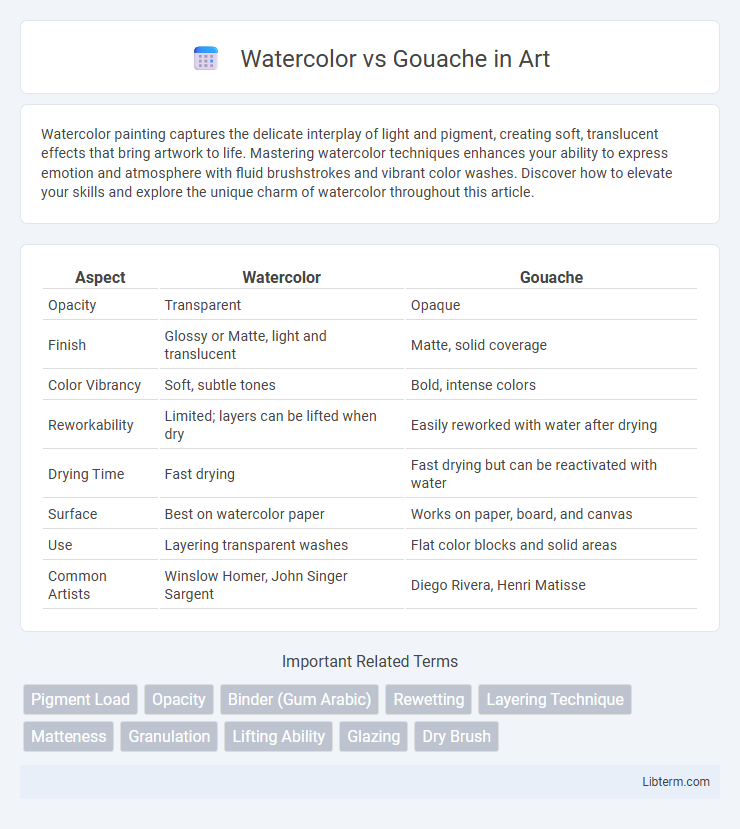Watercolor painting captures the delicate interplay of light and pigment, creating soft, translucent effects that bring artwork to life. Mastering watercolor techniques enhances your ability to express emotion and atmosphere with fluid brushstrokes and vibrant color washes. Discover how to elevate your skills and explore the unique charm of watercolor throughout this article.
Table of Comparison
| Aspect | Watercolor | Gouache |
|---|---|---|
| Opacity | Transparent | Opaque |
| Finish | Glossy or Matte, light and translucent | Matte, solid coverage |
| Color Vibrancy | Soft, subtle tones | Bold, intense colors |
| Reworkability | Limited; layers can be lifted when dry | Easily reworked with water after drying |
| Drying Time | Fast drying | Fast drying but can be reactivated with water |
| Surface | Best on watercolor paper | Works on paper, board, and canvas |
| Use | Layering transparent washes | Flat color blocks and solid areas |
| Common Artists | Winslow Homer, John Singer Sargent | Diego Rivera, Henri Matisse |
Introduction to Watercolor and Gouache
Watercolor paints are transparent, allowing light to pass through the pigment and reflect off the paper, creating luminous effects ideal for delicate washes and layering. Gouache, on the other hand, is an opaque medium with a higher pigment concentration and added chalk or white pigment, offering vibrant, matte finishes and excellent coverage. Both mediums use water as a solvent, but their distinct opacity and texture differences make them suitable for varied artistic techniques and styles.
Key Differences Between Watercolor and Gouache
Watercolor paint is transparent, allowing light to pass through and create luminous washes, while gouache is opaque due to its higher pigment concentration and added chalk or white pigment. Watercolor typically dries to a glossy finish, enabling subtle layering and blending, whereas gouache dries matte, providing solid coverage and vibrant color blocks. The reactivation properties differ as watercolor easily reactivates when wet, while gouache is more resistant, making gouache ideal for corrections and flat, bold artwork.
Composition and Ingredients
Watercolor and gouache differ significantly in composition and ingredients, impacting their opacity and texture. Watercolors are composed of finely ground pigments suspended in a water-soluble binder, typically gum arabic, resulting in transparent, luminous washes. Gouache contains similar pigments but includes a higher ratio of pigment to binder and additives like chalk or white pigment, producing a thicker, opaque finish that allows for layering and reworking.
Opacity and Transparency
Watercolor is prized for its transparency, allowing light to pass through the pigment and reflect off the paper, creating luminous washes and subtle color blending. Gouache, by contrast, offers higher opacity due to its heavier pigment concentration and added chalk or inert white, enabling solid, matte layers that easily mask underlying colors. This difference in opacity and transparency distinctly influences their use in layering techniques and final artwork appearance.
Color Vibrancy and Finish
Gouache offers a more opaque and matte finish compared to watercolor, resulting in more vibrant and solid colors that stand out boldly on paper. Watercolors provide a translucent, luminous finish that allows light to reflect off the paper beneath, creating softer and more subtle color vibrancy. Artists often choose gouache for graphic, flat color applications, while watercolor excels in layered washes and delicate gradients.
Techniques and Application Methods
Watercolor techniques emphasize transparency and layering by applying diluted pigments on paper to create light washes and delicate gradients. Gouache allows for more opacity, enabling artists to use flat color blocks, reworking layers easily, and achieving solid, matte finishes ideal for illustrations and graphic work. Both mediums require control over water-to-pigment ratios, but gouache demands thicker application and often a dry brush for texture, while watercolor benefits more from wet-on-wet and wet-on-dry methods for fluid blending.
Surface Compatibility
Watercolor and gouache differ significantly in surface compatibility due to their pigment concentration and opacity. Watercolors require highly absorbent, textured cold-pressed or rough watercolor paper to allow pigments to blend transparently, while gouache works well on both smooth hot-pressed paper and more textured surfaces because of its opaque, dense pigments. Artists often choose gouache for non-porous surfaces like illustration board or canvas because it adheres strongly and can be reworked, whereas watercolor performs best on specialized watercolor paper designed to handle dilution and layering.
Drying Time and Reworkability
Watercolor dries quickly, typically within 15-30 minutes, allowing for fast layering but limits extensive rework once dried. Gouache has a slightly longer drying time, around 20-40 minutes, and remains more reworkable even after drying due to its opaque and water-reactivatable properties. Artists prefer gouache for corrections and adjustments, while watercolor suits rapid, transparent applications with less flexibility for extensive reworking.
Best Uses for Watercolor vs Gouache
Watercolor excels in transparent washes ideal for landscapes, portraits, and delicate layering techniques, providing a luminous, ethereal quality to artworks. Gouache offers opaque coverage suitable for graphic illustrations, bold backgrounds, and detailed designs with vibrant, matte finishes that stand out under varied lighting. Choosing between watercolor and gouache depends on the desired texture, opacity, and finish, with watercolor favored for subtle translucency and gouache preferred for rich, vivid color application.
Choosing the Right Medium for Your Art
Watercolor offers transparency and fluidity ideal for delicate washes and layering effects, while gouache provides an opaque finish perfect for bold, vibrant colors and detailed work. Choosing the right medium depends on your desired outcome; watercolor suits artists seeking subtle gradients and light textures, whereas gouache is favored for graphic designs and illustrations requiring solid coverage. Consider factors like drying time, opacity, and reusability to align your medium choice with your artistic style and project requirements.
Watercolor Infographic

 libterm.com
libterm.com